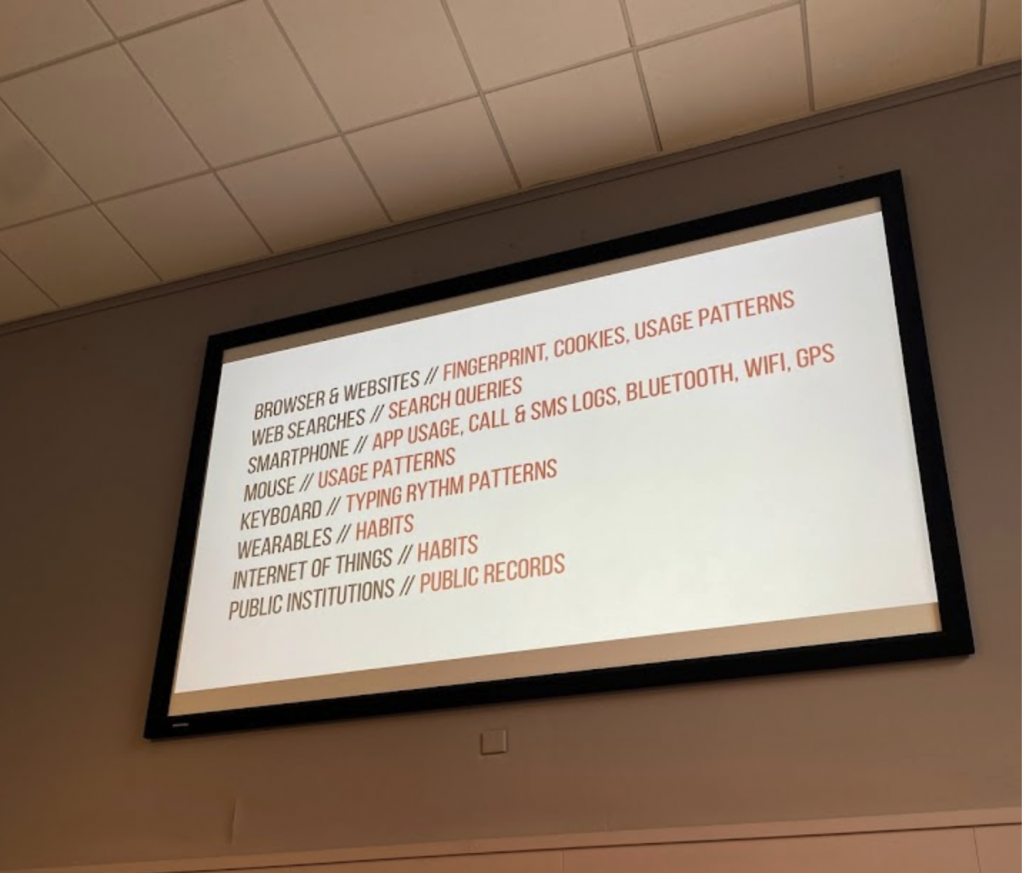The In-Between Media Conference opened up with remarks from internet critic and INC founder, Geert Lovink. After three years without a full INC conference (the prior being MoneyLab in November 2019) Geert was notably happy of being able to gather with a large number of people in the same room. This fact was not to be underlooked, as this very conference was financed by a grant written in the midst and as a consequence of the Covid pandemic and the anxieties around public gatherings it generated. Furthermore, this was also the first full-scale conference organized after a generational renewal at the Institute of Network Cultures. In a way, this conference symbolized an ending, that of the pandemic and the traumas of heavily mediated social interactions, and a beginning, of a new team and goals at INC.
Geert commented on the reasons this event came to be as well as its objectives: after the isolating Covid pandemic, how can we think and act in hybrid terms? How can we bring together people that are not in the same place? These questions have to be tackled through new hybrid practices and tactics for organizing, streaming, and reporting events. The In-Between Media Conference attempts to be an experiment in these practices while creating a forum for sharing expertise on how to use (digital) media tactically. Lovink also commented on how after the Covid pandemic we quickly moved on to another crisis: the war in Ukraine. Finally, he stressed that the different research lines pursued by INC -hybrid events, meme research, tactical media in the war, and experimental (video) publishing- come together under the question concerning the aesthetics and politics of moving images. Or, in other words, the tactical media question: how can we make local and temporal connections using media? How can we make a hybrid combination of connections?

Geert Lovink opens the Going Hybrid conference.
These remarks were followed by the conference’s opening lecture: “Data Extraction, Materiality, and Agency” by Catalan researcher and artist Joana Moll. Her lecture focused on the tension between interfaces and internet infrastructure. The internet is perhaps the largest infrastructure ever built but, although it is ultimately physical and has very material consequences, it remains largely invisible to users. These can only access the internet through interfaces, to the point that, from their perspective, the internet becomes a synonym for the interface. Ever-prevalent, the interface dictates what we can and cannot do.
In one of those occasions where entrepreneurial naivete somehow possesses an enlightening clarity, Moll quotes Bill Gates: “power in the digital age is about making things easy”. Interfaces smoothen interactions, making them seem obvious or natural – “some years ago we had to connect to the internet, today we have to disconnect from it”, Moll stated. The places where interaction is streamlined are also sites of power struggles. This smoothening takes away agency from users and gives economic and informational power to big tech companies. Moll traces this back to the ideology embedded in the business model of these companies; what she calls, following other theorists, Cognitive Capitalism. The technology companies’ wealth is no longer produced by material goods, but through intangible actions, such as human communication, experience, and cognition, which are later translated into numbers – quantifiable terms that can be translated into electricity.

Joana Moll, opening lecture.
The business model of the web primarily relies on ad tech, which trades user attention in the same way that stocks are exchanged in financial markets. Ad tech comprises many different services and products such as analytics, content management systems, etc. It is a complex ecosystem whose main goal is to map and target user behavior. The analogy with financial markets is not obvious nor natural, but rather a set of decisions taken to assimilate networked communication to neoliberal markets. Decisions that were taken during the early 2000s after a migration of Wall Street financial workers to Silicon Valley tech companies. In this context, financial workers applied their working logic to newly-born tech startups. As the 2016 study, “Networks of Control ” shows, every time we do something online, a collection of other things are happening – every action is registered and analyzed as classifiable behavioral traits to target and predict future user actions. User tracking, or the process of collecting any activity done by users on the internet, is possible because of cookies – a tiny piece of software invented in 1994 by Lou Montulli. According to Joana Moll, cookies represented a shift from the internet as a place of anonymity to one where everything is potentially recorded. Montulli didn’t create cookies for this purpose, but he acknowledged early on their potential to create a massive surveillance state.

Lou Montulli, inventor of cookies.
User tracking spawned data markets and brokers. Companies such as Acxiom and Oracle boast about having data for 700 million people and the ability to sort them under (absurd yet cynical) user profiles such as “shooting stars” – gen Xers with expendable income, no children, and who are into jogging. These pseudo-sociological analyses claim to use over 3000 different attributes (in the case of Acxiom). Joana underlined how the mere idea of coming up with 3000 different attributes is absurd. Inviting us to reflect on how many distinct attributes we can come up with (100? 200?), she implicitly posed the question of how these analyses fetishize quantification without knowing exactly how and what they’re quantifying. Moreover, she played a promotional video from Hotjar, a company that places cookies on websites to track every mouse movement and displays them with heat maps. Heat maps show which areas the user is interacting more with and, therefore, those where interaction with advertisement can be maximized. Yet, no matter how much these advertising solutions brag about their accuracy, they deliberately fail to understand the reflexive quality of the interactions between humans and these virtual environments. By understanding action as reactive behavior, they regard interactions with interfaces as a natural given, a necessary relationship, rather than something that has been designed and is contingent on cultural, economic, and political inertias and desires. This probably also works against the commercial interests of these services’ customers: a static analysis wouldn’t take into account that placing a new ad on spots where interaction is concentrated might drastically change how users interact with the website. Moreover, it wouldn’t surprise me (the author of this report) that the results visualized in these analyses will probably be painfully obvious. Like many digital visualizations, these strike as a contrived and ineffective way to state the obvious,
legitimized by a lack of trust towards non-quantitative forms of thought as well as an avoidance of political and epistemic liability.

How our everyday use of technology is translated into datafied interactions.
In a key slide of her presentation, Joana detailed how our everyday use of technology is translated into datafied interactions (see picture above): browsing becomes use patterns, web searches into queries, smartphone use into call logs, app usage, and wifi or GPS connection points. The machine is not concerned with our personal (metaphysical) identity or our reflexive (intentional) actions, but with very concrete patterns of movement. With this in mind, Joana stated that there is a huge difference between what we share, what our behaviors tell big tech companies, and what the machine thinks about us (how poor or rich we are, and ultimately how likely are we to buy again). At the end of the day, it really doesn’t matter if the analysis is correct or true, what is relevant is that it is productive: that we click/buy again and self-fulfill the predictive prophecy. Even if seemingly understandable at first sight, this data is solely machine-readable, it doesn’t possess any meaning in the same way we think about meaning when interacting with text and images. That’s what Ad Tech analytic services are there for – to provide a resemblance of meaning to aggregated data (and of course charge a premium fee for it). So, it doesn’t matter if regulation requires tech companies to give users the ability to retrieve “their” data. Even if this requirement is fulfilled, users receive unreadable spreadsheets (millions of interactions sorted out using thousands of attributes, which don’t make sense in isolation but only when aggregated with data from multiple users). The idea that we own our data in the same way that we possess an identity or private property falls flat. It’s a legal fantasy that ultimately benefits the very companies it wants to regulate.
After setting the stage with this articulation of the data political economy, Joana presented her web-based installation, Carbolytics. Made in collaboration with the Barcelona Supercomputing Center, Carbolytics measures the carbon impact of tracking cookies in the top 1 million websites. The carbon footprint of online advertising is 60 million metric points (the equivalent of 60 million flights between London and New York). This represents 10% of the total energy used by the internet. However, these are all estimates, since there’s no proper agreement on how to calculate the energy consumption of the internet.
Finally, she concluded with a final reflection: we, users, don’t go to websites, the website is coming to us with cookies. Cookies don’t only suck data, but also energy from our computers. Joana closed her talk with a clear political proposal: energy consumption must be included in the privacy rights narrative.


